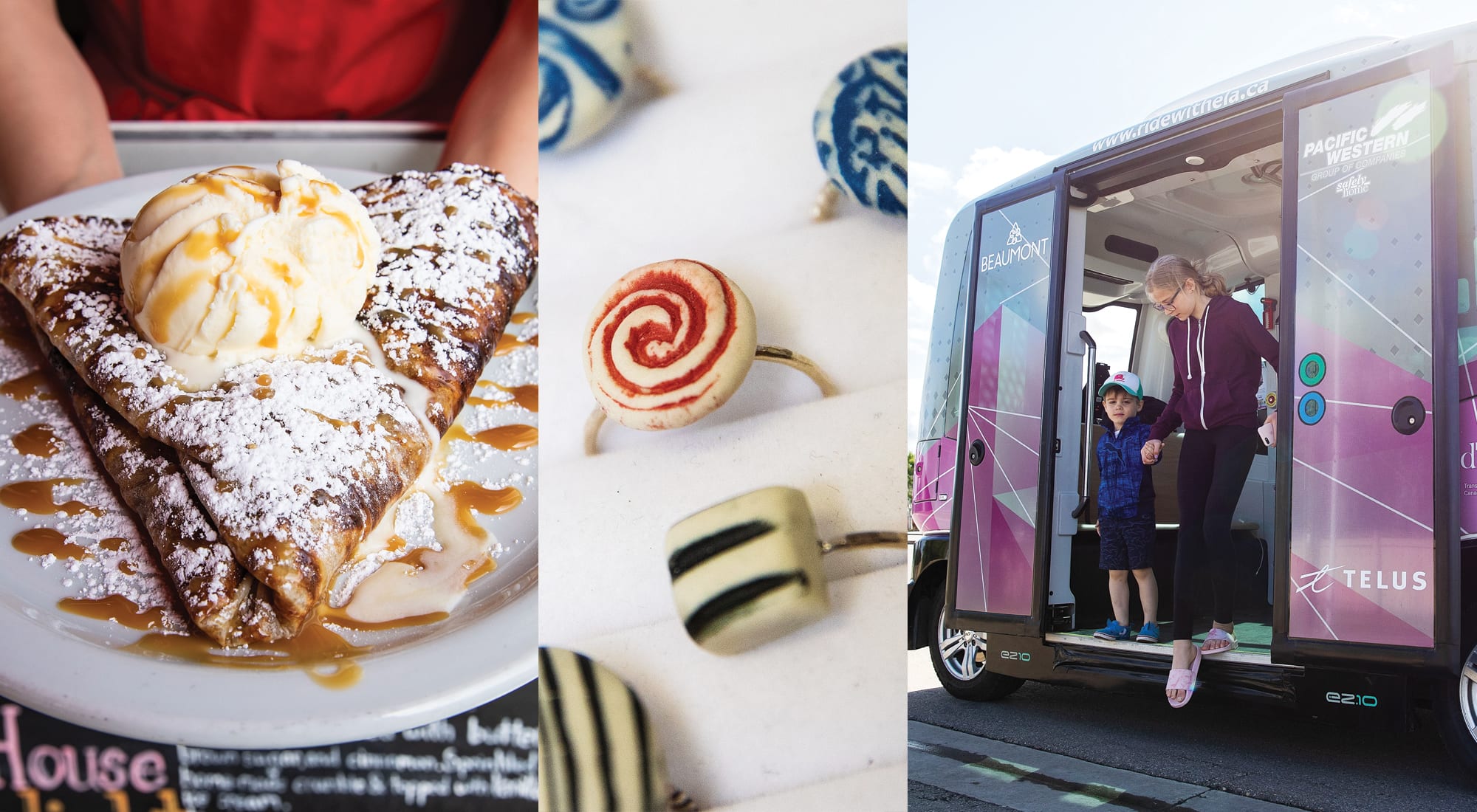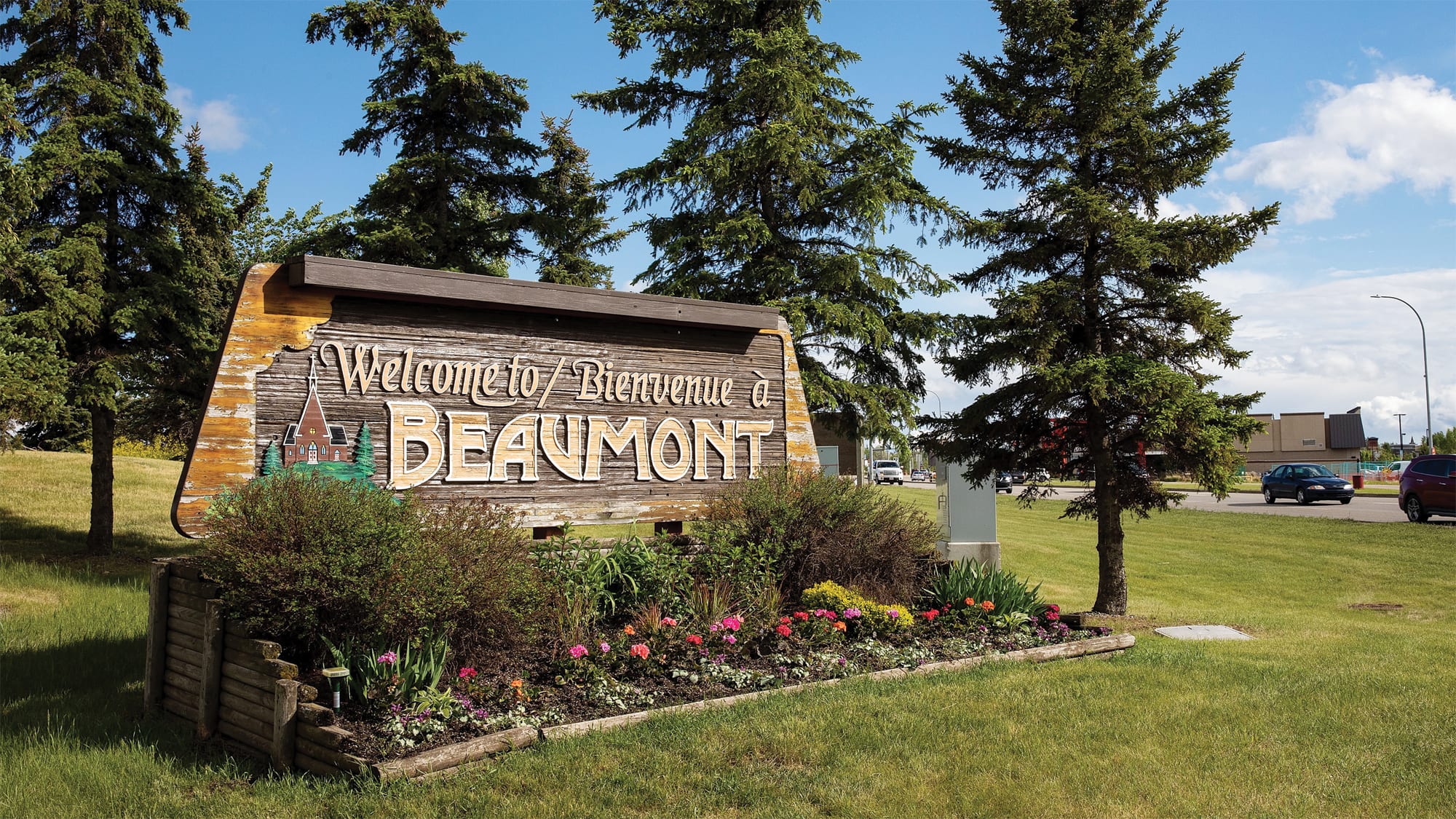On January 1, 2019, Beaumont became Alberta’s newest city. Just 30 minutes from downtown Edmonton, the charming community has French-Canadian roots, a burgeoning music festival, walking trails and a century-old church perched on a beautiful hill—hence its name.
OUT & ABOUT
Snack: Savour history alongside homemade chocolates at Crêpe & Shake, located in a former convent established by a trio of nuns. From May to September, the shop also sells crêpes and milkshakes—made with ingredients from its own garden. 5110 50th Ave.
Shuttle: Until October 1, you can take a spin through town on ELA, an electric autonomous vehicle (supervised by an operator). The shuttle makes three stops along 50th Street, including the Ken Nichol Regional Recreation Centre and Coloniale Way. Sign up at ridewithela.ca.
Sparkle: Pick up some vibrant, locally produced art, jewellery and sundries at Painted Door on Main. The downtown shop, run by a non-profit group of artisans, sells everything from stained glass decorations, leather bracelets, vegan soap and handcrafted pens. 5013 50th St.
MORE TO READ
The Old West meets new in Cochrane, Alberta
Share: If downtown is the heart of Beaumont, Four Seasons Park/Parc Quatre Saisons is its soul. The 21-hectare park, with its trout-stocked lake, walking paths and sports fields, also hosts the city’s Christmas festivities and the Beaumont Blues & Roots Festival. 5417 43rd Ave.

DEEP ROOTS
Chartier is one of Beaumont’s biggest draws. The rustic French-Canadian brasserie specializes in hearty poutine, beef bourguignon and galettes. Aided by a crowdfunding campaign, Sylvia Cheverie and her husband, Darren, opened the eatery in 2016. Here, she dishes about her booming business and Beaumont itself.
You lived in Edmonton for years. Why open a restaurant in Beaumont?
I was born and raised here. My family has been here for over a century. Yes, we moved back from Edmonton to open the restaurant, but a huge part of that decision was for our daughter Rowan. Having her in a tighter-knit community, with smaller class sizes, where everybody knows everybody—it was perfect for us.
What’s it like to start a business here?
The community is very supportive. We love it here and we’re so grateful. Residents want to see businesses do well and they’re craving more restaurants and retail stores, so they’re great at rallying around the entrepreneurs who do set up shop here.
How has Beaumont evolved?
When I was growing up, there weren’t even traffic lights. There were only four-way stops. As Beaumont expanded, we saw a lot of big-box stores open on the outskirts of town. Even though we just got our city designation, it still feels very much like a small town—like everybody is looking out for one another.
MORE TO READ
Architectural highlights across Alberta
How French is Beaumont these days?
You’d be surprised! We get a lot of guests who will only speak in French. We often host French immersion students—they want to practice in an everyday setting.
What are some of your favourite things to do around town?
My girlfriends and I like to go for walks—Four Seasons Park is awesome for that. And Saint Vital Parish is lovely: Darren, Rowan and I will often go there at night to watch the stars. You feel as though you’re on top of the world.

ON THE MOVE
Beaumont is something of a late bloomer. Officially founded by French-Canadian farmers in 1895, fewer than 6,000 people lived in the community during its first century. “We didn’t have a railway line, so we didn’t grow quickly,” says Carole Hudson, president of the Beaumont & District Heritage Society.
Since the mid-’90s, Beaumont’s population has tripled to more than 18,000, making it the fifth-fastest growing community in Canada. (Beaumont is also one of only four officially bilingual municipalities in Alberta.) New houses abound, but residents still embrace the past. Street names pay tribute to the area’s first Francophone families, while the Heritage Society works to preserve some of the city’s older buildings.
One of those is St. Jacques House, built in 1912. It used to sit next to the community’s 100-year-old church, Saint Vital Parish, and its cemetery. In 2018, the white house was moved down the hill to Parc Beacon Park. This historic family home is expected to open as a museum in 2020.
